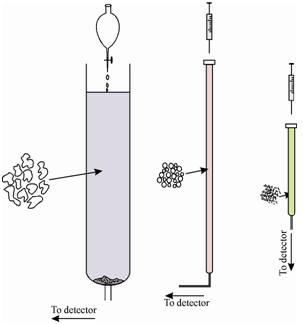Principle:
The basic principle of separation by high performance liquid chromatography is similar to classical liquid or column chromatography (LC) though it differs with regard to the size of the column and the sample. It differs from LC in terms of speed, automation, elution time and individual manual assays of collected fractions. In case of HPLC, microgram amounts of the sample is allowed to pass through a column containing stationary solid inert phase coated with nonvolatile liquid phase by means of pressurized flow of a liquid mobile phase where components migrate at different rates due to different relative affinities. Comparison of column size features of packing material and pressure needs to force the mobility of mobile phase in classical column chromatography and HPLC are illustrated in Figure. According to another version, HPLC may be considered as partition chromatography where stationary phase is a second liquid coated on an inert surface and it is immiscible with the liquid mobile phase. According to the stationary liquid phase, the technique may be subdivided into two types; liquid-liquid and liquid-bonded phase chromatography. These differ from each other in the way stationary phase is held on to the support particles of the packing. In LLC, the polar liquid is physically adsorbed on to an inert surface where it competes with the mobile phase. However, in case of bonded phase chromatography and liquid is chemically bonded making it more stable.
(a) (b) (c)
Particle size: >150 µm 40-70 µm 5-10 µm
Column diameter: 10-50 mm 1 - 3 mm 2 - 6 mm
Column length: 50-200 cm 50-100 cm 10-50 cm
Pressure: < 1 atm 30-50 atm 100-200 atm

Figure: Comparison of characteristics of various forms of liquid chromatography: (a) Classical column chromatography; (b) HPLC with pellicular packing; (c) HPLC with microparticulate packing